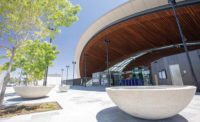Global Best Projects 2018
Global Best Projects 2018 Project of the Year and Best Rail: Sydney Metro Northwest SVC Contract

Crews used two gantry cranes designed and produced in Italy to install precast yard molds produced in China. The cranes placed approximately 1,200 concrete precast segments, as long as 60 meters, to form the deck of the 4-kilometer viaduct structure.
PHOTO COURTESY TFNSW AND ISJV

A 270-m-long cable-stayed railway bridge soars over a major road carrying 50,000 vehicles a day.
PHOTO COURTESY TFNSW AND ISJV

Sydney Metro Northwest SVC Contract
PHOTO COURTESY TFNSW AND ISJV

Contractor’s dual gantry system was able to place a variety of segments significantly faster than conventional systems.
PHOTO COURTESY TFNSW AND ISJV

Contractor’s dual gantry system was able to place a variety of segments significantly faster than conventional systems.
PHOTO COURTESY TFNSW AND ISJV

The viaduct and cable-stayed bridge are part of the first phase of a transit expansion that supports Sydney’s growing suburbs.
PHOTO COURTESY TFNSW AND ISJV

The viaduct and cable-stayed bridge are part of the first phase of a transit expansion that supports Sydney’s growing suburbs.
PHOTO COURTESY TFNSW AND ISJV







Sydney Metro Northwest SVC Contract
Sydney
Best Project
Owner Transport for New South Wales (TfNSW)
Lead Design Firm SMEC—Australia & New Zealand Division
Lead Contractor Salini Impregilo
General Contractor ISJV
Independent Certifier APP/Arcadis
A signature 270-meter-long curved cable-stayed bridge is soaring over a major road carrying 50,000 vehicles a day in Sydney—the centerpiece of a $6.1-billion Metro Northwest project that will link the city’s northwestern suburbs with its center. A global team led by Italy’s Salini Impregilo used an innovative technology that allows for simultaneous launching of two spans at a time.
Building information modeling helped to address significant torsional effects due to the curvature of the deck in the presence of railway and stay loads. Seven major roads and a busway stayed open during construction. The surface and viaduct civil works (SVC) project, which commenced in 2014, also achieved the highest possible score from the Infrastructure Sustainability Council of Australia. Workers hailing from 50 different countries performed nearly 4.3 million hours on the job, resulting in a lost-time injury rate of 0.1.
Two giant horizontal cranes, or gantries, began assembling the skytrain in 2016. Each gantry was 150 m long and weighed 600 tonnes. Sitting atop the 30-m-tall piers, the cranes placed some 1,200 concrete precast segments, as long as 60 m, to form the deck of the 4-kilometer viaduct structure, tensioned with steel cables.
The two identical gantries were manufactured by COMTEC, with the support of designers and engineers of Salini Impregilo who were experts in segmental bridge construction, according to the team. They were able to erect two simply supported spans simultaneously with the span-by-span method. For a three-span continuous configuration, the team used a mixed solution—a span-by-span system integrated with a balance cantilever system. This method increased the clearance and minimized temporary prestressing.
This system, which Salini Impregilo first developed and utilized for a highway in Dubai, allowed crews to handle different configurations of the project, including the construction of the curved cable-stayed bridge over a road crossing.
Project officials say the span-by-span method for simple spans was as much as 120% faster than conventional methods. For continuous spans, the hybrid system was between 30% and 50% faster, depending on the span length. Moreover, conventional underslung machines cannot erect long continuous spans without temporary supports on the ground—not an option in this setting.
Each girder is unique and is match-cast against the previous segment to ensure complete continuity at the joints. A sophisticated software-based geometry control was set up and implemented to drive the cast and shape of each single girder. The girders making up the cable-stay bridge, supported by 40-m-tall towers, were particularly challenging due to the significant curvature. Engineers had to address prestressing staging and uplift forces at the foundation level generated by eccentricities of future train loads.
The viaduct construction ran into problems in 2016. According to local media reports, the team had to tear down or partially replace three precast concrete spans damaged by cracking. Another span buckled upwards by about 1.5 m in 2016. Despite these hurdles, the viaduct section was completed on time and the overall Sydney Metro Northwest project is more than $300 million under budget, according to owner Sydney Metro.
The alignment includes two elevated stations. A train will run along the line every four minutes at the peak when services start in the first half of 2019. Not only will the system provide a critical link between downtown and growing communities, but community input informed key design elements, including environmental considerations, according to Sydney Metro. These encompassed width and depth ratios of the viaduct, including the support columns, to ensure it is well-proportioned and context-sensitive. The skytrain incorporates sustainability initiatives such as water collection and minimizes impacts on local floodplains.
Rail infrastructure elements such as acoustic sound walls, downpipes and lighting have been incorporated into the design holistically and in a way that can be successfully maintained. For instance, noise attenuation features run along its length as an integral part of the design.
The design also means that any future upgrade of the Windsor and Schofields road intersection will not be impacted by the operation. It also minimizes impacts on local flood plains.
Last year, Salini Impregilo received a “Leading” As Built IS rating from the Infrastructure Sustainability Council of Australia. With design partner SMEC, the contractor in 2015 won a Leading Design IS rating for designing the project in the most environmentally friendly way possible.












